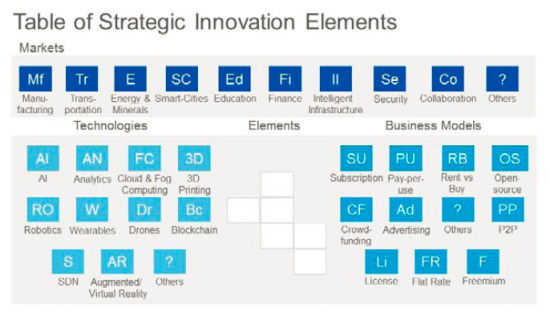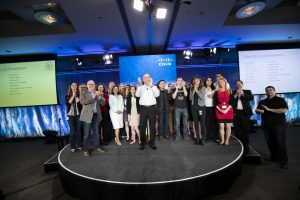































Before you can disrupt markets and competitors with breakout innovations,you must first disrupt yourself.
This new paradigm does not discriminate. It applies now to all organizations of any size,their cultures and employees alike -no matter how successful in the past.
Overwhelming research*shows that organizations must constantly reinvent themselves -and their cultures -to keep pace with the accelerated speed of change powered by today's digital economy. Today, it's either disrupt or be disrupted. Pioneer or perish. Transform or terminate. Innovate or disintegrate.
change powered by today's digital economy. Today, it's either disrupt or be disrupted. Pioneer or perish. Transform or terminate. Innovate or disintegrate.
Fast!
At Cisco, we taking these transitions very seriously. We recently shook things up almost overnight across all Cisco functions, grade levels and geographies among the company's 72,000-person workforce. We knocked down walls of resistance, overcame barriers to change, and broke through siloes of business units. Along with a collaborative network of internal and external partners, our team launched the Innovate Everywhere Challenge, a uniquely designed program that encouraged each employee to think and act like an entrepreneur in a startup -a Lean Startup.
(You can download a comprehensive white paper on the Innovate Everywhere Challenge here, and listen to a 30-minute broadcast withInnovation Leader Livehere.)
We challenged our workforce to tap into their passions, team up outside their siloes, and co-innovate disruptive customer solutions beyond the focus of their day jobs. We encouraged employees everywhere to form cross-functional teams where every voice is welcomed, heard, and respected, regardless of grade level, experience or location.
The results were simply mind-blowing -nearly 50% of our workforce from 50 countries participated!
In effect, the Innovate Everywhere Challenge empowered and "freed" all employees to act on their own dreams for market disruption - in a collegial, fun, game-like atmosphere. More than 2,000 employees and teams submitted over 1,100 ideas.
To start this transformation, we secured leadership support from CEO Chuck Robbins and Chief People Officer Fran Katsoudas, along with "co-conspirators" from 16 functions, including Engineering, Human Resources, IT, Legal, Employee Communications, and Startup//Cisco.
We also plotted the disruption by refining insights from industry best practices, partner experiences, startup advisors, and proven startup tools such as Adventure Kits, which were notably inspired by Adobe Kickbox - an open source innovation toolkit with step-by-step guides that take an entrepreneur through the innovation journey.
Of course, Cisco has already amassed a 30-year history of Engineering leadership and distinctive innovation programs, but the Challenge was our first to break through organizational siloes and bring together all employees around common passions -existing projects in their day jobs were not eligible.
We focused the Challenge on these goals:
We asked cross-functional teams to refine disruptive solutions around key markets, technologies and business models (see graphic, Table of Strategic Innovation Elements). And to polish and pitch their ventures to the entire company as well as panels of internal and external industry judges.
Innovation Elements). And to polish and pitch their ventures to the entire company as well as panels of internal and external industry judges.
Thanks to our creative minds and exceptional partnership with Employee Communications, we kept the buzz loud, constant and consistent throughout the four startup-like phases -ideation, investigation, seed funding, and implementation. Employees cast nearly 46,000 votes and made over 4,100 online comments about the entries.
Momentum built to a crescendo through a series of transparent, promotional events and Lean Startup boot camps driven by Startup//Cisco, a complementary grassroots effort created to rekindle Cisco's startup DNA, aimed at innovating the right thing, in less time with fewer resources. Fifteen semifinalist teams received specialized training, help on their venture pitches, and mentorship to remove roadblocks or enhance the success of their ventures.
After six months, more than 250 judges and employee voters whittled down those 1,100 entries to six finalist teams. The Challenge culminated in the grand finale where finalists made rapid-fire pitches and demos before a panel of eminent internal and external judges that was broadcast companywide. We announced the three winners a couple of days later at a companywide meeting:
Each winning team received$50,000, technology and advisory resources as well as the option for time off to bring their ideas to life. But this does not end with the winning team. We are helping all semifinalists move their ventures forward by matching funds they can secure from corporate sponsors. We are seeing some customer and product success already.
 By all accounts, many of the winning and non-winning ventures demonstrated high promise to disrupt or create new industries in a wide range of markets. I can gladly say that the results of our inaugural Challenge exceeded all expectations, and we've build a solid foundation to take future innovations to the next level.
By all accounts, many of the winning and non-winning ventures demonstrated high promise to disrupt or create new industries in a wide range of markets. I can gladly say that the results of our inaugural Challenge exceeded all expectations, and we've build a solid foundation to take future innovations to the next level.
So what were the key lessons learned? There were so many, which again are detailed in our white paper. Here are a few thoughts though that are top-of-mind for me:
First, I think it's paramount to focus on the innovator -not the innovation.This means cultivating an environment where the employee feels empowered and encouraged to pursue his or her own dream. It also means providing the employee with clear Lean Startup processes, tools, technologies and coaches to go from concept to market.
Second, it's critical to build a grassroots, inter-connected network -an innovation community -both within and outside the organization.Internally, this must start at the top -any grassroots revolution like this needs strong, clear, and bold leadership. It also meansyou will need a diverse network of mentors and coaches who can help navigate innovators around obstacles, whether it's to better understanding markets, technologies and business priorities or simply organizational politics, and success factors. And when it comes to innovation, mentors who facilitate development are more valuable than traditional managers.
Third, listen and learn from your employees at the outset and along the way, and remain flexible in adjusting your course if necessary.It's more important to generate enthusiasm than it is to have a rigid game plan. Also, wherever there is change, there will be resistance. We discovered these challenges through an employee survey on fostering innovation, and addressed them up front. This included making sure that the company will follow through to support the winning innovators with significant funds, guidance and time off.
Based on the success of the Innovate Everywhere Challenge, we have regrouped with our stakeholders to take the initiative quantum leaps forward. Along with HR's People Deal with employees, we are mapping out our own "My Innovation." This program will accelerate a culture of entrepreneurial innovation by making it easier for every Cisco employee who is inspired by disruptive change.
We are also building end-to-end innovation hubs for all creative ideas, we're piloting innovation rooms across various Cisco locations, and we're working with everyone everywhere to expand our mentor network.
The Innovate Everywhere Challenge is just the beginning of our revolution ahead. In today's chaotic world of change, we know that disruptive innovation -organizational, cultural and individual - must be constant, continuous, and convergent.
*
 Hot Tags :
Innovation
#Collaboration
Alex Goryachev
Disruption
Hot Tags :
Innovation
#Collaboration
Alex Goryachev
Disruption